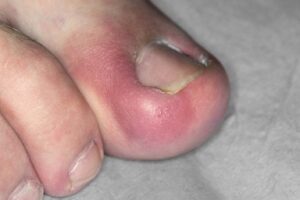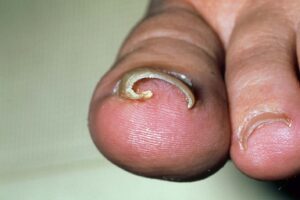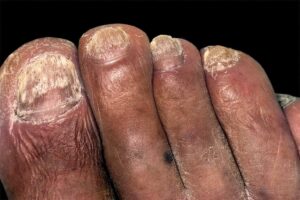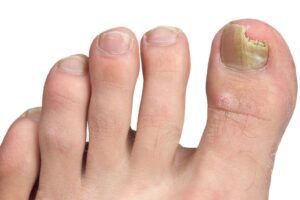Nail condition
Nails can change shape, become thicker, or discoloured. This can sometimes cause discomfort. This page will guide you through the most common nail conditions, what symptoms to look out for, and provide some advice on how to self-care.
Ingrown toenail
Ingrown toenail
An ingrown toenail is a common problem where the nail grows into the toe. It can be painful, but there are things you can do to ease the pain.
Symptoms of an ingrown toenail
You usually get an ingrown toenail on your big toe. But you can get them on any toe.

Your toe may be red, painful and swollen.

Your toenail may curve into your toe.
Your toe can also get infected.
Signs of an infected toe include:
- pus coming out of it
- you feel hot or shivery
How to treat an ingrown toenail at home
If you go to a GP with an ingrown toenail, they’ll usually suggest you try these things first.
Do
- soak your foot in warm, salty water to help soften the skin around your toe and reduce the chances of infection
- keep your foot dry for the rest of the day
- wear wide, comfortable shoes or sandals
- take paracetamol or ibuprofen to ease the pain
Don’t
- do not cut your toenail, leave it to grow out
- do not pick at your toe or toenail
- do not wear tight, pointy shoes
A pharmacist can help with an ingrown toenail
You can ask a pharmacist about:
- treatments to help ease the pain and prevent an infection
- whether you need to see a GP
See a GP if:
- treating your ingrown toenail at home is not helping
- your toe is painful and swollen with pus coming out of it
- you have a very high temperature or you feel hot or shivery
- you have diabetes and an ingrown toenail, foot problems can be more serious if you have diabetes
Treatments for an ingrown toenail
A GP can:
- check to see if you have an ingrown toenail
- give you antibiotics if your toenail is infected
If you have a badly ingrown toenail, they may refer you to a foot specialist (podiatrist).
Treatment from a foot specialist
A podiatrist may offer further treatments, such as:
- cutting away part of the nail
- removing the whole nail
You may have an injection of local anaesthetic to numb your toe when this is done.
Referral to a podiatrist on the NHS may not be available to everyone and waiting times can be long. You can pay to see a podiatrist privately.
How to prevent ingrown toenails
To help stop ingrown toenails:
- do not cut your toenails too short
- cut straight across the nail, not the edges
- do not wear shoes that are too tight or do not fit properly
- keep your feet clean and dry them thoroughly
Nail surgery patient
Nail surgery patient
Before the procedure
- In advance of any surgical procedure it is important that an assessment is undertaken. You will be asked questions about your general health and foot condition. Your family doctor may be contacted to make sure you are well enough to have nail surgery.
- The podiatrist will discuss with you treatment options which may include having a total or partial section of the nail being removed.
- On the day of surgery have your normal breakfast or lunch.
- Remove any nail varnish from the nails before you arrive.
- Wash your feet and wear clean socks or tights.
- Arrange for a taxi or a relative or friend to provide a lift home for you afterwards. You must not drive after the procedure until the effects of the anaesthetic have worn off. This may take several hours.
- Bring any tablets or medication that you normally use throughout the day, for example, inhalers.
- Bring some roomy footwear such as slippers, flip-flops or open toed sandals as you will have a dressing on your toe or toes.
- We strongly recommend that a parent or legal guardian accompany any patient under the age of 18. Children under 16 must be accompanied by a parent or legal guardian otherwise the procedure will not be undertaken.
During the procedure
- The procedure will take approximately one hour.
- Please inform the podiatrist of any changes in your medication or health. A procedure checklist will take place to review your health status has not changed and surgery is still required.
- A local anaesthetic is used to numb the toe. These injections are very safe but you may experience some discomfort. The local anaesthetic used is not licensed for use in podiatry on children under 14 but is licensed for use by dentists. However this anaesthetic is commonly used by podiatrists on children.
- Once the toe is numb, the podiatrist will place an elastic ring over the toe. This stops the toe bleeding during the procedure.
- The podiatrist will then remove part or all of the toenail.
- Once the nail has been removed, a chemical called phenol is rubbed into the nail bed to prevent the nail from growing back. In rare cases, phenol will not be applied and the nail will be left to grow back.
- The phenol is washed off and the elastic ring is removed.
- A sterile dressing is placed around the toe which you will need to keep on and keep dry until your first dressing appointment.
After your procedure
Healing times
This will vary with most toes healing between 4 to 8 weeks. However this depends on a number of factors, for example, infection, age, general health, activity levels and your compliance in following the podiatrist’s instructions.
Driving
Your toe may remain numb for several hours. Do not drive immediately after surgery until the effects of the anaesthetic have worn off.
Pain relief
You must rest your foot as much as possible for the remainder of the day. You might experience some discomfort once the anaesthetic wears off. If you need to take medication to control the discomfort we advise that you take your normal painkiller, for example, paracetamol. Do not take aspirin as pain relief. However, if you take a low dose of aspirin as part of your prescribed daily medication, continue taking as indicated by your GP.
Activities
If you have an office-based job, attend school or college you can return the following day. For other jobs where you stand or walk a lot, your podiatrist will advise. You are strongly recommended not to participate in any sporting activities until advised by your podiatrist.
Dressings
After the surgery you are expected to keep the toe clean and covered. You might notice some discharge or spots of blood on the dressing, this is quite normal. If the initial dressing starts to come loose you can apply some more surgical tape to hold it in place.
The dressing will be changed at your first follow up appointment.
After this your podiatrist or practice nurse will arrange review appointments as required.
Urgent attention
If you experience any unexpected pain in your toe or become concerned please contact your local clinic where you will be attending for your follow up dressings and speak with a podiatrist. If this is not possible please contact Leeds community podiatry service during working hours from 8:30am to 4pm (3:40pm on Fridays), call 0113 843 0730.
Dressing your toe
- Keep the dressing clean, dry and intact until your first dressing appointment.
- Apply the new dressing and using the technique shown by the podiatrist
- Keep your dressing as dry as possible when bathing. It is best to change your dressing after bathing in case it has got wet.
- If your dressing gets wet it is important to change it to a new dry one. This will help reduce the risk of infection and aid the healing process.
- You will initially be required to change the dressing every 1 to 3 days, ask the podiatrist if you are unsure.
Risks associated with nail surgery
Infection
Every precaution is taken during the procedure to prevent an infection. However, because we are dealing with an open wound, it is inevitable that a small number of cases may develop an infection. Keeping your dressing dry and following the advice of the podiatrist will reduce the risk of infection.
Phenol burn
Occasionally the phenol used to stop the nail regrowing can spread onto the surrounding skin. You may experience some discomfort and this may delay the healing time. Every precaution is taken to prevent this.
Excessive bleeding
There is little or no bleeding during the procedure. However, bleeding may occur afterwards. Appropriate dressings will be used to help this.
Pain following the operation
Once the local anaesthetic has worn off you may feel some pain or discomfort. Your podiatrist will advise you on how to treat this.
Numbness
In a very small number of cases the nerve may be damaged by the needle. This numbness can last up to 3 to 4 months.
Local anaesthetics
In rare instances the local anaesthetic is not effective and the operation will need to be rescheduled.
Allergies
If you have ever had an allergic reaction or have felt unwell following a local anaesthetic, for example after dental treatment, you may have an allergy (similar to nut allergy). If you have had this type of reaction please inform the podiatrist.
Latex allergy and sensitivity
This can cause a skin reaction or affect your breathing. Please inform the podiatrist if you have a skin sensitivity or are allergic to latex and rubber gloves.
Nail appearance
The cosmetic appearance of the nail will be permanently changed. In a small number of cases the whole or part of the nail may grow back.
Fungal nail infection
Fungal nail infection
You may have a fungal nail infection if your nail is brittle, discoloured or thicker than usual. These types of infections are not serious but they can take a long time to treat.
Symptoms of a fungal nail infection
Fungal nail infections usually affect your toenails, but you can sometimes get them on your fingernails, too.

Fungal nail infections usually start at the edge of the nail.

The infection often spreads to all of the nail, making it thicker and turning it white or yellow.

The nail may become brittle and crumbly. The whole nail can sometimes lift off, causing the skin around it to become swollen and painful.
A pharmacist can help with fungal nail infections
Speak to a pharmacist if the look of your nail bothers you or it’s painful.
They may suggest trying an antifungal nail medicine that you brush onto the affected nail.
These medicines:
- should be used daily or weekly, depending on the type
- need to be used for 6 to 12 months, it may take several months before you start to see an improvement
- may not be suitable for you if you’re under 18, pregnant or breastfeeding
The infection is cured when you see healthy nail growing back at the base.
See a GP if:
You have a fungal nail infection and:
- the infection is severe and treatment has not worked
- the infection has spread to other nails
- you have diabetes, foot problems can be more serious if you have diabetes
- you have a weakened immune system, for example, you have had an organ transplant or are having chemotherapy
Treatment for a fungal nail infection
A GP can prescribe antifungal tablets if you have a fungal nail infection and treatments from a pharmacy have not worked.
But before they give you tablets, they should take a sample of your nail and have it tested, to find out what type of infection you have.
You may also need to have a blood test before starting treatment and during treatment to check your liver is working properly.
You may need to take antifungal tablets for up to 6 months.
The tablets can have side effects, including:
- headaches
- an itchy rash
- stomach ache
- feeling sick and diarrhoea
You cannot take antifungal tablets if you have certain conditions, such as liver or kidney disease. They may also not be suitable if you’re pregnant or breastfeeding.
Badly infected nails sometimes need to be removed. It’s a small procedure done while the area is numbed (under local anaesthetic).
Preventing fungal nail infections
You can get a fungal nail infection if your feet are constantly warm and damp.
You’re more likely to get an infection if you wear trainers for a long time and have hot, sweaty feet.
There are some things you can do to help prevent fungal nail infections.
Do
- treat athlete’s foot as soon as possible to avoid it spreading to nails
- keep your nails short
- Keep your feet clean and dry
- wear clean socks every day
- wear flip-flops in showers at the gym or pool
- wear shoes that fit well and do not have high heels or narrow toes
- Throw out old shoes
Don’t
- do not wear shoes that make your feet hot and sweaty
- do not share towels
- do not wear other people’s shoes
- do not share nail clippers or scissors
A guide to cutting and filing toenails
A guide to cutting and filing toenails
Before you start, ask yourself
- Is there enough light?
- Am I sat safely?
- Do I have everything I need?
- Nails are generally easier to cut after a bath or shower as they are softer.
- Sitting safely. Put two chairs together opposite one another. Sit against the back of the supporting chair. Put your heel on the chair in front of you. Keep your knee bent so you can reach your foot easier. It may help you reach if you point your knee outwards whilst it is bent. This also applies when applying moisturiser to your feet. Alternatively you may wish to do this sat on your bed with your feet resting on the bed using a towel to protect your bedding.
- Use a pair of nail clippers. Do not share these with other people. Try and cut nails straight across, gently follow the contour of the nail. Do not cut too short or down the sides. Clear debris such as soap, cream, sock fluff from the sides of the nails using a soft toothbrush. Gently file any rough or sharp edges.
- If may be safer for you to file your nails. This will need doing once a week to keep them at a short comfortable length. You can also reduce the thickness of nails by filing across the entire surface of the nail.
- Use a clean long nail file. File away from yourself across the front edge of the nail. Only use enough pressure to gradually reduce the nail.
- You can also use a file or pumice stone to reduce hard skin. Only use enough pressure to gradually reduce it. Avoid causing abrasions to the skin.
- If you do cause a bleed firmly apply pressure to the area with some gauze or similar product for a couple of minutes. Checked the bleeding has stopped. Apply a dry dressing.


